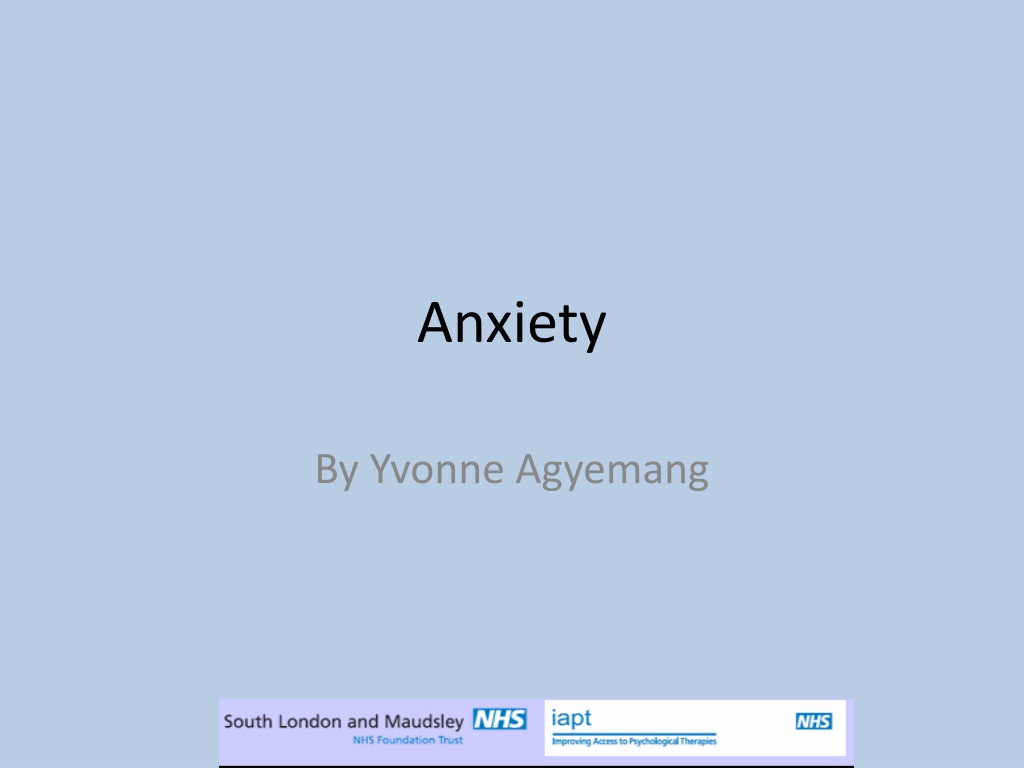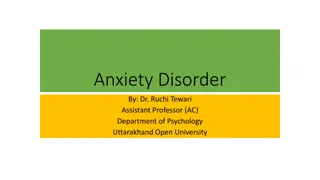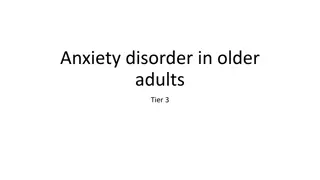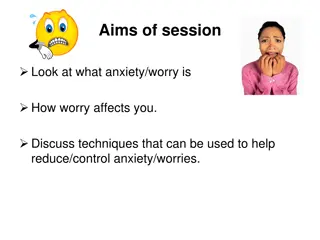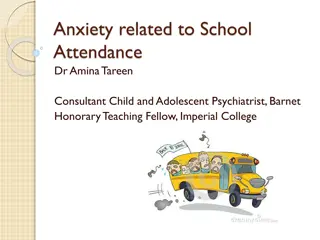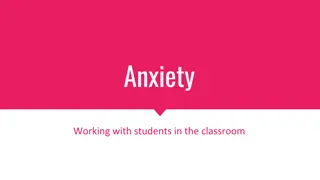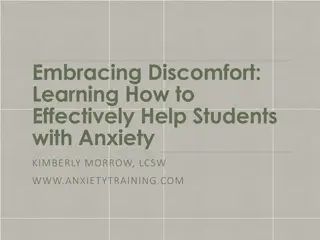Understanding Anxiety: Symptoms, Causes, and Cultural Variances
Explore the complexities of anxiety, its symptoms, triggers, and common treatments. Delve into the prevalence of anxiety across different cultures and understand how it manifests. Join a supportive group offering tools for managing anxiety and creating a safe space for exploration and improvement.
Download Presentation

Please find below an Image/Link to download the presentation.
The content on the website is provided AS IS for your information and personal use only. It may not be sold, licensed, or shared on other websites without obtaining consent from the author. Download presentation by click this link. If you encounter any issues during the download, it is possible that the publisher has removed the file from their server.
E N D
Presentation Transcript
Anxiety By Yvonne Agyemang
What will the group involve? Our part To provide a safe place to explore your difficulties Based on Worry Time, Problem Solving and Progressive Muscle Relaxation which is recommended by NICE for treating anxiety
What will be covered What is anxiety? Possible triggers to anxiety? First steps to feeling better What are Worry Time, Problem Solving and Progressive Muscle Relaxation? Getting to know the link between our anxiety- seeking reassurance, worrying and avoidance
Housekeeping Phones off Respect one another A lot to get through Not talking over each other Confidentiality Any thing else?
Symptoms of Anxiety Panic attacks (separate workshop on this which goes into more detail. We will be focusing more on Generalised Anxiety Worrying about everything and finding it hard to stop worrying Troubles concentrating and sleeping Feeling restless and tense Reduction of energy Physical symptoms- increased heartbeat, sweating, dizziness Sense of dread and constantly feeling on edge Irritability
How Common Is Anxiety? Feeling worried is a normal part of being human It is a common condition and estimated to affect 5% of the UK population (NHS website, 2020) Reported by more women than men
Anxiety across cultures In some cultures it is common to use the psychological term of anxiety. In some cultures this word does not exists and may be better described as nervousness (Martinez, 2020) Research indicates that certain anxiety disorders (e.g., generalized anxiety disorder and panic disorder) may vary greatly in rate across cultural groups. It indicates that the clinical presentation of anxiety disorders, with respect to symptom presentation and the interpretation of symptoms, varies across cultures (Marques et al, 2014)
Other symptoms of anxiety? Are there any other symptoms or ways in which anxiety is understood or manifest in your own cultural background?
Triggers to Anxiety If anxiety manifests in symptoms then it is important to think about the triggers or things that lead to anxiety What has made you feel anxious in the past?
Triggers to Anxiety? Stress- unable to balance lots of different demands and worries about how you are going to be able to cope Being a worrier- worrying about lots of different things Financial Concerns- Worrying about money, being in debt Significant life events- death of someone close, moving houses, having a baby, getting married Racism - experiencing discrimination at work or in searching for work, feeling excluded in college can lead to low mood, affect self esteem, motivation etc . Personal Relationships pressures (within the family and outside of the family difficulties in relationships at home can affect our mood health issues, employment or housing issues, caring responsibilities etc Migration difficulties with migration status, feeling isolated and missing family from the country of origin, difficulties with integrating to the new community, language difficulties can all lead to low mood Struggling with cultural differences between expectations of own cultural background and the dominate culture
Case Study Jack struggles with GAD It interferes with his ability to do everyday things as he constantly worries about whether or not he is making the right decision. He also always thinks about the worst case scenario He constantly finds himself trapped in a cycle of anxiety, causing him to always feel restless and on edge. As a result his sleep is impacted and he is often irritable with others Jack has always been a worrier but now struggles to stop worrying. He also worries about the fact that he worries so much and the impact that this may have on his health Sometimes he thinks that worrying is a useful way to prevent things going wrong. However, he wishes he could stop worrying and over analyzing everything
How It Can Affect Us Behavioural- Worrying, seeking reassurance from others and putting things off/avoiding doing things Physical- Sweating, disturbed sleep, headaches, irritable, tired, pins and needles and tension Thoughts- Tend to be predicting that something bad is going to happen and unable to stop ourselves from worrying
Summary of Cycle of Worry When we are worrying about something we tend to avoid solving the problem, seeking reassurance from others or worrying These behaviours maintain symptoms of anxiety as we are not dealing with the issue at hand As a result we continue to worry that something bad is going to happen and therefore keep the fight and flight system going, which maintains the physical symptoms of anxiety The key to start feeling better to replace worrying, seeking reassurance and avoiding things with other tools which will break the cycle.
Worry Worry can be helpful- helps us problem solve Worry can be unhelpful when it is excessive, predicts the worse and gives us physical symptoms or anxiety- headaches, tension, troubles concentrating People who worry may start to worry about the fact they are worrying so much and what this may mean for their health, or what this says about them as a person.
Different types of Worry Practical Worries: These are worries that are often affecting you now and for which there is a practical solution. For example, these can include things like I haven t paid the gas bill this quarter Hypothetical Worries: This type of worry is often about things that may be well in the future and may not have a solution no matter how hard you try to find one. For example What if the plane crashes on the way to Manchester? , What if the bus is late tomorrow to take me to the hospital? ,
Managing Worries Practical Worries: Problem solving is an evidence-based intervention that helps you initially distance yourself from your worries to help you think about different types of practical solutions that there may be. Hypothetical Worries: Worry time is giving yourself time to worry, but at a time that you choose and are more in control of during the day. When you are worrying it can distract your focus away from what you are doing in the present moment onto future concerns.
Problem Solving Step 1: Identify the worry you want to focus on Step 2: Convert the worry into a practical problem Step 3: Identify solutions Step 4: Analyse the strengths and weaknesses of each solution Step 5: Select a solution Step 6: Develop a plan Step 7: Put your plan into action Step 8: Review your plan
Worry Time Step 1: Plan your worry time A time where you can spend 10 minutes worrying Step 2: Write down your hypothetical worries Acknowledge that they are there, do not try to stop them and write them down Step 3: Refocus on the present moment Color distraction technique or 5 sense technique Step 4: Your scheduled worry time - Now worry! Worry as much as you want to for 10 minutes and end with a mentally exhausting task
Progressive Muscle Relaxation Our bodies respond automatically to stressful situations and thoughts by becoming tense. The opposite relationship also works: a good way of relaxing the mind is to deliberately relax the body. In a progressive muscle relaxation each muscle group is tensed in turn, and the tension is then released.
